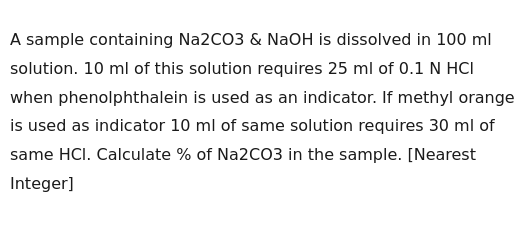Question
Question: A sample containing Na2CO3 & NaOH is dissolved in 100 ml solution. 10 ml of this solution requires 2...
A sample containing Na2CO3 & NaOH is dissolved in 100 ml solution. 10 ml of this solution requires 25 ml of 0.1 N HCl when phenolphthalein is used as an indicator. If methyl orange is used as indicator 10 ml of same solution requires 30 ml of same HCl. Calculate % of Na2CO3 in the sample. [Nearest Integer]

40
Solution
Let “a” = moles of Na₂CO₃ and “b” = moles of NaOH in 10 mL aliquot.
-
With phenolphthalein: NaOH: NaOH + HCl → NaCl + H₂O (1:1) Na₂CO₃: Na₂CO₃ + HCl → NaHCO₃ + NaCl (1:1) Thus, b + a = (25 mL × 0.1 N)/1000 = 0.0025 eq (1)
-
With methyl orange: NaOH: NaOH + HCl → NaCl + H₂O (1:1) Na₂CO₃: Na₂CO₃ + 2HCl → 2NaCl + H₂CO₃ (1:2) Thus, b + 2a = (30 mL × 0.1 N)/1000 = 0.003 eq (2)
Subtract (1) from (2): (b + 2a) – (b + a) = 0.003 – 0.0025 ⇒ a = 0.0005 moles
Substitute into (1): b = 0.0025 – 0.0005 = 0.0020 moles
Calculate mass in 10 mL aliquot:
- Na₂CO₃: 0.0005 moles × 106 g/mol = 0.053 g
- NaOH: 0.0020 moles × 40 g/mol = 0.080 g
Since these values are for 10 mL, in 100 mL solution they’ll be 10× higher:
- Na₂CO₃ = 0.053 g × 10 = 0.53 g
- NaOH = 0.080 g × 10 = 0.80 g
Total sample mass = 0.53 g + 0.80 g = 1.33 g
Percentage of Na₂CO₃ in the sample = (0.53/1.33) × 100 ≈ 39.85% ≈ 40%
